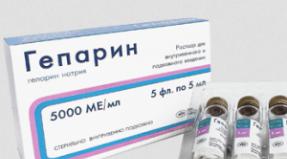Suprax solutab 400 instructions for use. Suprax tablets: instructions for use. Pregnancy and lactation
One tablet contains 400 mg cefixime (the amount of Cefixim trihydrate substance is 447.7 mg).
Also, the following excipients are included in the tablets: povidone, hyprolose, colloidal silicon dioxide, magnesium stearate, calcium saccharinate trisesquihydrate, cellulose, sunset yellow dye, strawberry flavor.
Release form
Dispersible tablets (soluble in water).
pharmachologic effect
Cephalosporin (3rd generation).
Pharmacodynamics and pharmacokinetics
Antibiotic Suprax (INN Cefixim) - semi-synthetic. It is easily and quickly absorbed into the digestive tract. Antibiotics of this series inhibit the activity of the cell membranes of harmful bacteria by inhibiting the synthesis of peptidoglycan. Active towards gram-positive and gram-negative bacteria .
This group of antibiotics, when released into the blood plasma, binds to proteins (). It is practically not metabolized in the organs, excreted in the urine in an almost unchanged form.
The price of an antibiotic is high, but this is fully justified by its effectiveness.
Indications for use
According to the instructions, the drug is intended for the treatment of inflammation caused by various infections, i.e. bacteria sensitive to action:
- infections respiratory tract (sinusitis, acute, agranulocytic tonsillitis, acute bronchitis, chranic pharyngitis, sinusitis, tonsillitis and bronchitis );
- shigellosis;
- uncomplicated (cervix, urethra).
Contraindications
Allergy to specific components of the drug. Not recommended for people with , at , pregnancy, elderly people.
Side effects
According to the annotation:
- allergy:, - rarely, drug fever - very rare;
- headache, tinnitus, dizziness;
- thrombocytopenia, bleeding, angranulocytosis - rarely;
- abdominal pain, indigestion, , nausea, vomiting - often;
- impaired renal function, nephritis - rarely.
Consult your doctor before use.
Application instruction of Supraks (Way and dosage)
How to take, before or after meals? The food intake does not matter.
How do I take the medicine? For adults and children weighing more than 50 kg, the daily dose is 400 mg of the drug in 1-2 doses. If the weight is from 25 to 50 kg - 200 mg per day at a time. The tablet is swallowed with plenty of water or a suspension is prepared (see instructions for use of the suspension). You can make sweet syrup for children.
The duration of treatment is prescribed by a doctor and depends on the severity of the type of infection, on average one or two weeks.
- at gonorrhea - 1 day;
- with mild forms of urinary tract infection - from 3 to 7 days;
- when a course of 7-14 days is prescribed (with angina in children, the daily dose is reduced);
Instructions on how to prepare the Suprax suspension. How to dilute it correctly?
Dissolve one tablet in a little water, shake well. It is worth diluting the suspension in a glass or enamel container. Let the mixture stand for 5 minutes, until the granules are completely dissolved. Shake well before use.
Overdose
Most often occurs with an increase in the daily dose, the frequency and intensity of manifestation side effects... Symptomatic treatment, gastric lavage , appoint antihistamines and glucocorticoids .
Interaction
- tubular secretion blockers (various diuretics , ) have the ability to delay renal excretion cefixime ;
- when using the drug together with, the level of concentration of the latter in the blood plasma may increase;
- significantly lowers prothrombin index , the effect of indirect anticoagulants is enhanced;
- it is not recommended to simultaneously take the drug with antacids containing magnesium or aluminum hydroxide, because absorption through the gastrointestinal tract will slow down.
Terms of sale
Dispensing of the drug from pharmacies is carried out by prescription.
Storage conditions
Keep out of the reach of children, in a dark, dry place, at a temperature not exceeding 25 ° C.
Best before date
Subject to storage conditions - 3 years.
Analogs Supraks Solutab
Matching ATX level 4 code:By release form: Suprax Solutab 400 mg tablets made in Russia and Italy, granules for the preparation of Suprax suspension.
In the Suprax analogue, the instructions for use should indicate that this is a third-generation cephalosporin drug and have cefixime as the main active ingredient.
Often the price for analogs is slightly lower. Common analogues of the Suprax antibiotic are Tsemidixor, Sumamed, Amoxilav. The best analogue for children is .
What is Pancef or Suprax better?
The active substance for both antibiotics is the same. There is an opinion that Pancef allergy is less common and its side effects are not so pronounced.
What is better Sumamed or Supraks?
- antibiotic based azithromycin , which has a broader antimicrobial effect. Sumamed is more suitable for children, causes fewer side reactions and has less course of treatment.
What is Suprax or Amoxiclav better?
Unlike Suprax, it is better tolerated and less likely to cause dysbiosis and other disorders of the gastrointestinal tract.
Synonyms
Ixim lupine , suprax , ceforal solutab.
Suprax for children
The dosage for children (weighing 25 to 50 kg) is 200 mg per day, at a time. At pneumonia and at in children, the course of treatment is 7-14 days. The antibiotic can be simply swallowed with plenty of water or a suspension. How to breed Suprax Solutab is described above.
Reviews about Suprax for children: reviews for the suspension for children are mostly positive, the drug is well tolerated, rarely occurs adverse reactions from the digestive tract.
With alcohol
During pregnancy and lactation
Suprax is used during pregnancy as a last resort when there is a threat to the mother's life. Taking the drug during pregnancy is highly undesirable.
During lactation, while taking an antibiotic, you should stop breast-feeding.
Suprax - cephalosporin antibacterial drug... In the instructions for use, it is described as a remedy capable of resisting infections caused by pathogenic bacteria.
Dosage forms of Suprax:
- Tablets. Tablet form Suprax Solutab dissolves in the oral cavity. Each contains 400 mg
active substance cefixime, has the shape of an elongated oval, yellowish, at risk in the middle. On one side of the tablet is the inscription "SUPRAX", on the other - "LUPINE".
The active ingredient that forms the basis of all four types of drugs is cefixime trihydrate. The trihydrate form of this substance allows it to pass unbroken through the active gastric environment. Then it enters the intestines and is carried from there. blood vessels throughout the body, getting into the organs affected by bacteria.
Inactive ingredients contained in tablets:
- dibasic anhydrous calcium phosphate;
- hypromellose;
- magnesium stearate;
- cellulose;
- polyethylene glycol;
- gelatinized starch;
- titanium oxide;
- triacetin;
- tartrazine.
In capsules:
- colloidal silicon oxide;
- enterosorbent crospovidone;
- low-substituted hydroxypropyl cellulose;
- magnesium stearate;
- mannitol;
- shellac.
Powder for suspension:

Pharmacological properties
The preparations consist of natural organic substances and a number of semi-synthetic compounds. Cephalosporin antibiotics exhibit biological activity against certain microorganisms and are able to stop the growth or destroy pathogenic bacteria.
Common signs of drugs:

Protection against bacteria is carried out by inhibiting the synthesis of mucoleptides in the bacterial cell wall. Cefixime stops the growth of bacteria, but does not destroy healthy tissue.
Through the bloodstream, the drug is carried throughout the body, “finds” harmful bacteria and infects them. Suprax is one of the most powerful antibiotics because it counteracts the enzymes that bacteria produce when protecting against antibiotics.
The bioavailability of the drug in the affected area is 45–55%, regardless of food intake. Food absorbed with the drug increases the absorption time by 0.7 hours. G max 200 mg tablets - 3.7 μg ∕ ml. The concentration of the suspension is 25–30% higher than that of the tablets.
A 400 mg capsule taken on an empty stomach is bioequivalent to a 400 mg tablet. Simultaneous intake with food reduces its absorption by 15%.
Peak concentration occurs between 2.5-6 hours after taking 400 mg suspension or tablets. Plasma protein binding does not depend on the accumulation of the drug and is 65%. After 24 hours, the active substance is excreted by 60% in the urine. Serum half-life is independent of dosage forms, is 3.5-4.5 hours.
Bacteria that cannot be treated with Suprax:

Indications for use
Suprax helps to heal uncomplicated bacterial infections arising in various organs.
It can be:
- ENT organs (pharyngitis, tonsillitis, sinusitis).
- Genitourinary system (cystitis, pyelonephritis, cholecystitis).
- Skin infections (phlegmon, abscess, boils).
- Respiratory tract (bronchitis).
- Infectious inflammations affecting the skeletal system.
- Enterococcus serogroup D.
- Infections urinary tract no structural changes.
- Uncomplicated urethral gonorrhea.
The drug successfully copes with purulent wounds, skin lesions caused by fungal pathogens. To reduce the development of drug-resistant bacteria and maintain the effectiveness of Suprax, it should only be used in the treatment of diseases caused by susceptible bacteria.
The transition from one form of medication to another, for example, from tablets to suspension, should take place only under the supervision of a physician. Do not take 2 doses of the drug at the same time.
Contraindications
Suprax, (the instructions for use contain recommendations for people who should refrain from taking the drug, and also consume it with extreme caution) is contraindicated in case of sensitivity to certain components.
Reasons for contraindications:

Instructions for use of Suprax and dosage
Cefixime, the active ingredient in Suprax, is well tolerated by most people. The medicine is taken orally with or without food, no more than 1 time per day, as directed by a doctor. Antibiotics work best when the amount of active ingredient in the body is kept constant.
Therefore, it must be taken evenly, at regular intervals, until the full prescribed amount has ended, even if the symptoms disappear after 2-3 days of taking. Stopping the antibiotic too soon causes bacteria to grow, which leads to a relapse of the infection.
The recommended dose of cefixime is 8 mg per kilogram, but not more than 400 mg daily for adults, as well as for children over 12 years of age weighing more than 45 kg. The tablet is taken whole, if desired, it can be divided in half, taking ½ part every 12 hours. In the presence of gonococcal infections, 400 mg of Suprax is prescribed once, or 20 ml of suspension. 
The medicine is taken regardless of food, the dose, the course of treatment is prescribed by the doctor. The optimal time of admission is 7 days. In cases of infection with pyogenic streptococcus, the tablets are taken for 14 days.
It is advisable to drink the tablets with bottled non-carbonated or boiled water, not less than ½ glass. Do not drink it with compote, tea or juice. The capsules must be swallowed whole; it is not recommended to empty the contents.
Doses for children in the pediatric ward are calculated based on body weight. When buying a drug with a dosage spoon in the package, there is no need to calculate the amount of the drug. For the treatment of otitis media, tablets cannot be replaced with a suspension.
When restoring a suspension from granules, water should be added in two stages, and then the solution should be allowed to settle for 5 minutes. When recovering, you must use the dosage spoon or special syringe included in the package. Measuring instruments such as a teaspoon or a pipette are not recommended.
Excess water above the set mark will disturb the concentration of the suspension. In this case, it will be unusable. The suspension is taken immediately, if necessary, it can be washed down with water. They take it at any time, regardless of food.
Doses of water required to restore the substance:
| The amount of the drug | Bottle size ml | Amount of water ml |
| 100 mg / 5 ml | 100 | 68 |
| 100 mg / 5 ml 200 mg / 5 ml | 75 | 51 |
| 100 mg / 5 ml | 50 | 34 |
| 200 mg / 5 ml | 26 | 17 |
| 500 mg / 5 ml | 20 | 14 |
| 500 mg / 5 ml | 10 | 8 |
 The reconstituted drug, if it is planned to be stored, should be tightly closed with a lid and left in a cool, dark place. It can be stored for no more than 2 weeks. Shake vigorously before use.
The reconstituted drug, if it is planned to be stored, should be tightly closed with a lid and left in a cool, dark place. It can be stored for no more than 2 weeks. Shake vigorously before use.
For children from 6 months to 6 years old, Suprax is given in the form of a suspension. Older children are prescribed pills, provided that parents watch how they chew them. Capsules are prescribed for adolescents from the age of 12, and only if the body weight exceeds 50 kg.
People having functional disorders the kidneys should not use the drug in capsules, but only a suspension or dispersible tablets. The dose of the drug (400 mg) does not depend on which organ is affected by the infection, it is always the same.
Duration of admission:
- infectious diseases of the ENT organs - 7-14 days;
- tonsillopharyngitis - up to 10 days;
- gonorrhea - one-time 1 tab 400 mg;
- diseases of female urinary tract without complications (urethritis) –3 –7 days;
- inflammation of the female upper urinary tract (pyelonephritis, cystitis) –14 days;
- infectious diseases of the male urinary tract without structural changes - from 1 to 2 weeks.
The basic rule for taking antibiotics is that the medicine must be taken in the next 2 days after all signs of infection have disappeared.
Side effects
Suprax describes the instructions for use as a remedy with a small amount side effects, can cause complications in the form of symptoms:

In addition to gastrointestinal disorders, other body reactions to the drug:
- Hypersensitivity. The occurrence of skin rashes, urticaria, angioedema and facial edema, serum sickness.
- Liver failure... When using Suprax, it is possible to change the level of alkaline phosphatase, the appearance of hepatitis, jaundice, hepatomegaly.
- Kidney deviations. Temporary increase in creatinine, acute kidney failure. Signs of deviation: cessation of urination, swelling of the legs, shortness of breath, convulsions, lethargy, paresthesia.
- Deterioration of the circulatory and lymphatic systems. Temporary thrombocytopenia (increased bleeding), a decrease in leukocytes, an increase in an intracellular enzyme that affects the contraction of the heart muscle may occur. There is a tendency to bleeding, hemolytic anemia, hypoprothrombinemia, neutropenia, thrombocytopenia, bone marrow depression.
- Disorders in the musculoskeletal system in the form of arthralgia.
- Abnormality of the respiratory system in the form of shortness of breath.
- Abnormal laboratory tests. The drug can affect an increase in the amount of bilirubin in the blood serum, a decrease in the values of hemoglobin, platelets, white blood cells, and cause false positive results in urine tests for diabetes.
Because the drug is a cephalosporin antibiotic used to treat many types of infections caused by bacteria, some patients experience rare but serious side effects:

In 30% of patients who took the drug, concomitant gastrointestinal disorders were: pain, flatulence, dyspepsia. Patients of pediatric age experienced the same symptoms.
Overdose
There is no specific antidote for overuse of cefixime. It is necessary to do a gastric lavage, take any absorbent, for example, activated carbon. Cefixime is not removed from the body by hemodialysis or peritoneal dialysis.
special instructions
Suprax, the instructions for use of which require special accuracy in dosage when used by people with functional renal impairment, should be taken with caution in patients undergoing peritoneal and hemodialysis on an outpatient basis. These patients should be monitored continuously.
Doses for patients with renal impairment:
| Suspension | Tablets | |||
| Creatinine | 100 mg / 5 ml | 200 mg / 5 ml | 600 mg / 5 ml | 400 mg Dose / day |
| 60 and more | Normal dose | Normal dose | Normal dose | Normal dose |
| 21 to 59 or renal hemodialysis | 13 | 6,5 | 2,6 | Does not fit |
| 20 or less, or continuous peritoneal dialysis | 8,6 | 4,4 | 1,8 | 0.5 tablets |
Cephalosporins, including Suprax, can cause a drop in prothrombin activity.
 The risk group includes patients:
The risk group includes patients:
- with renal or hepatic impairment;
- poor nutrition;
- undergoing long-term antimicrobial therapy;
- previously stabilized on anticoagulant therapy.
Suprax "flushes" vitamin K from the body. This should be borne in mind by those who use it to strengthen skeletal system and better blood clotting. Scientists' studies have not revealed signs of fetal damage by cefixime during pregnancy, but doctors suggest using it in extreme cases, with caution.
Also, the moment of passage of Suprax into mother's milk has not been studied. Doctors recommend refraining from using it during lactation. The safety of using Suprax in children under the age of 6 months has not been established. People 65 and older need to be corrected medicinal dose due to different pharmacokinetic parameters in young and old people.

The drug should be used with extreme caution in people with gastrointestinal diseases. Long-term use disrupts the microflora, which leads to the emergence of anaerobic bacteria of the genus Clostridia, which can cause severe diarrhea and colitis. Taking this medication can cause ear noise, dizziness, therefore, it is undesirable to drive cars and work with moving mechanisms.
With prolonged use of the drug, it is necessary to monitor the hematopoietic system.
Drug interactions
Suprax, the instructions for use of which contain not only a list of side effects, but also the nature of the interaction with various drugs must be taken with caution in conjunction with other medicines. 
- Anticoagulants. Simultaneous administration of Warfarin, Coumadin and Suprax reduces prothrombin time and leads to clinical bleeding.
- Antacids. Preparations containing magnesium, aluminum hydroxide inhibit the absorption of Suprax. They are taken after Suprax (in 1.5-2 hours) or before it (in 4 hours).
- Diuretics. They delay the excretion of the active substance by the kidneys, which leads to an increase in toxicity in the body.
- Drugs used to treat neuralgia trigeminal nerve, antiepileptic from the group of carboxamide derivatives. Simultaneous reception of Suprax with Carbamazepine, Carbatrol, Epitol, Tegretol increases the plasma antidepressants.
- Birth control pills. Take Suprax with caution, as some antibiotics reduce the effectiveness of contraception. During this period, it is better to use barrier methods of protection.
- Aminoglycosides. Increases the risk of nephrotoxicity.
The simultaneous reception of Suprax with herbal preparations increases the risk of bleeding.
These are herbal products:
- anise;
- arnica;
- celery;
- chamomile;
- Carnation;
- garlic;
- ginger;
- ginseng;
- horse chestnut;
- licorice;
- Red clover;
- turmeric;
- fenugreek.
Analogs
Pharmaceutical companies produce 2 types of analogs - drugs that have different names, but coincide in the active substance. These are synonymous drugs. And drugs that have a similar treatment effect, but with a different active ingredient. These are analog drugs.
The first group includes medicines containing the active substance cefixime:

The second group includes drugs belonging to the cephalosporin group, like Suprax itself. They contain other active substances, but the therapeutic effect is the same as that of Suprax.
Suprax's analogs:
- Azaran.
- Buperazon.
- Biotraxon.
- Vicef.
- Kefotex.
- Claforan.
- Lifaxon.
- Medaxon.
- Oritax.
- Pactcephus.
- Sulceph.
- Triaxon.
- Cefatrin.
- Cefosin.
- Cefotaxime.
- Ceftriaxone.
- Betasporin.
- Lendacin.
- Movigil.
- Movoperiz.
- Operaz.
- Sulcephazon.
- Talcef.
- Ceperon.
- Cefabol.
- Cebanex.
- Fortum.
- Fortazim.
- Oframax.
Terms, conditions of sale and storage
The instructions for use of the drug indicate that Suprax can be stored at room temperature, away from light and moisture, or refrigerated for up to 14 days. It is undesirable to keep it in the bathroom. The diluted suspension must be tightly closed and subsequently shaken well before use. 
All medicines should be kept out of the reach of children and animals. Capsules, tablets, unused suspension are stored at a temperature of + 20˚… + 25˚C. The drug belongs to list B, dispensed from pharmacies on a prescription form.
The price of Suprax in pharmacies in Moscow, St. Petersburg, regions
The price of a medicine in Moscow and the region:
- The drug is in capsules, 400 mg, 6 pcs. –598–749 rubles.
- Tablets in a contour cell, 6 pcs. - 560-700 rubles.
- Granules for suspension recovery 100 mg / 5 ml - 560–650 rubles.
Price in regions:
- Capsules 400 mg - 650-750 rubles.
- Granules for reconstitution of suspensions 100 mg / 5 ml bottle 60 ml –560–620 rubles.
- Tablets in a contour cell, 400 mg, 6 pcs. - 600-740 rubles.
The price of a medicine in St. Petersburg:
- Suprax 100 mg / 5 ml, bottle 60 ml - 600-650 rubles.
- Suprax capsules 400 mg - 600-700 rubles.
- Suprax tablets 400 mg - 750-800 rubles.
The drug Suprax has high efficiency, ease of use in case of illness of children, rare cases of allergic reactions. The instructions for use indicate that a mandatory consultation with a doctor is required before use.
Article formatting: Mila Friedan
Video about Suprax
Indications for the use of Suprax:
The active ingredient of Suprax is cefixime.
Pharmacological properties
Suprax - refers to the semi-synthetic antibiotics of the cephalosporin series.
Shows a pronounced bactericidal effect.
Has a destructive effect on many gram-negative, gram-positive microorganisms.
Indications
Infectious and inflammatory diseases caused by microorganisms sensitive to the drug:
- acute bronchitis and Chronical bronchitis;
- sinusitis;
- acute otitis media;
- streptococcal tonsillitis and pharyngitis;
- uncomplicated gonorrhea;
- uncomplicated urinary tract infections;
- shigellosis.
Release form
Dispersible tablets of 400 mg No. 1, No. 5, No. 7, No. 10 (5x2).
Mode of application
The duration of the course of treatment is determined by the doctor individually, depending on the severity of the course of the disease.
The tablet can be swallowed with water or diluted in water.
The drug can be used regardless of food intake.
Adults and children over 12 years old - the daily dose is 400 mg in 1 or 2 doses.
The course of treatment for infections of the respiratory tract and ENT organs is 7-14 days.
For uncomplicated infections of the lower urinary tract in women, the drug is prescribed for 3-7 days, the upper urinary tract - 14 days.
For infections of the upper and lower urinary tract in men, the duration of treatment is 7-14 days.
Children
Contraindicated for use in children under 12 years of age.
Use during pregnancy or lactation
Use during pregnancy or lactation only if the benefit to the mother outweighs the potential risk to the fetus or baby.
If necessary, use during lactation should stop breastfeeding.
Application features
The drug is used with caution in patients with severe renal failure, patients on hemodialysis or peritoneal dialysis.
Contraindications
- hypersensitivity to active substance or any other of the excipients of the drug;
- porphyria.
Side effects
When using, such side reactions may occur.
- nausea, vomiting, diarrhea, heartburn;
- indigestion, abdominal pain;
- headache, dizziness;
- hives, skin rashes, itching;
- increased body temperature, swelling of the face;
- transient leukopenia , agranulocytosis, pancytopenia.
Interaction with other medicinal products and other forms of interaction
When using cefixime with probenecid (and other tubular secretion blockers), the excretion of cefixime through the kidneys slows down, which can lead to symptoms of an overdose.
Cefixime reduces the prothrombin index, enhances the effect of indirect anticoagulants.
Furosemide, aminoglycosides increase the toxic effect of cefixime.
The ability to influence the reaction rate when driving or driving other mechanisms
Taking the drug can cause dizziness, drive a car and engage in activities requiring increased concentration of attention and speed of psychomotor reactions is not recommended.
Overdose
In case of an overdose of the drug, the risk of occurrence side effects... Symptomatic therapy is indicated.
Registration number: LSR-005995 / 10-020914
Tradename: Suprax® Solutab®
INN or grouping name: Cefixime
Dosage form: dispersible tablets
Compound:
1 tablet contains:
Active substance:
cefixime - 400 mg (as cefixime trihydrate 447.7 mg)
Excipients:
microcrystalline cellulose, low-substituted hyprolose, colloidal silicon dioxide, povidone, magnesium stearate, calcium saccharinate trisesquihydrate, strawberry flavor (FA 15757 and PV 4284), sunset yellow dye (E110).
Description
Oblong tablet, pale orange in color, scored on both sides, with a strawberry odor.
Pharmacotherapeutic group: Antibiotic cephalosporin.
ATX code:
Pharmacological properties
Mechanism of action
Semisynthetic antibiotic from the group of III generation cephalosporins for oral administration. Has a bactericidal effect. The mechanism of action is associated with inhibition of the synthesis of the bacterial cell wall. Cefixime is resistant to β-lactamases produced by many gram-positive and gram-negative bacteria.
Spectrum of antimicrobial activity
In conditions clinical practice and in vitro the efficacy of cefixime has been confirmed in infections caused by Streptococcus pneumoniae, Streptococcus pyogenes, Haemophilus influenzae, Morachella catarrhalis, Escherichia coli, Proteus mirabilis, Neisseria gonorrhoeae.
Cefixime also has in vitro activity against gram-positive - Streptococcus agalactiae and gram-negative bacteria - Haernophilus parainfluenzae, Proteus vulgaris, Klebsiella pneumoniae, Klebsiella oxytoca, Pasteurella multocida, Providencia spp., Salmonella spp., Citrobacterus
Resistant to the drug are Pseudomonas spp., Enterococcus spp., Listeria monocytogenes, most strains of Enterobacter spp., Staphylococcus spp. (including methicillin-resistant strains), Bacteroides fragilis, Clostridium spp.
Absorption
When taken orally, bioavailability is 40-50% and does not depend on food intake. The maximum concentration in blood plasma (Cmax) in adults after oral administration at a dose of 400 mg is achieved after 3-4 hours and is 2.5-4.9 μg / ml, after administration at a dose of 200 mg - 1.49-3.25 μg / ml. Food intake does not significantly affect the absorption of the drug from the gastrointestinal tract.
Distribution
The volume of distribution with the introduction of 200 mg of cefixime was 6.7 liters, upon reaching the equilibrium concentration - 16.8 liters. About 65% of cefixime binds to plasma proteins. The highest concentrations of cefixime are found in urine and bile. Cefixime crosses the placenta. The concentration of cefixime in the blood of the umbilical cord reached 1 / 6-1 / 2 of the drug concentration in the mother's blood plasma; v breast milk the drug is not detected.
Metabolism and excretion
The half-life in adults and children is 3-4 hours. Cefixime is not metabolized in the liver; 50-55% of the dose taken is excreted in the urine unchanged within 24 hours. About 10% of cefixime is excreted in the bile.
Pharmacokinetics in special clinical situations
If the patient has renal failure, an increase in the half-life can be expected and, accordingly, more high concentration the drug in plasma and slowing down its elimination by the kidneys. In patients with creatinine clearance of 30 ml / min, when taking 400 mg of cefixime, the half-life increases to 7-8 hours, the maximum plasma concentration averages 7.53 μg / ml, and excretion in the urine within 24 hours is 5.5%. In patients with liver cirrhosis, the half-life increases to 6.4 hours, the time to reach the maximum concentration (TCmax) is 5.2 hours; at the same time, the proportion of the drug eliminated by the kidneys increases. Cmax and area under the pharmacokinetic curve do not change.
Indications for use
Infectious and inflammatory diseases caused by microorganisms sensitive to the drug:
- streptococcal tonsillitis and pharyngitis;
- sinusitis;
- acute bronchitis;
- exacerbation of chronic bronchitis;
- acute otitis media;
- uncomplicated urinary tract infections;
- uncomplicated gonorrhea;
- shigellosis.
Contraindications
Hypersensitivity to cefixime or drug components;
- hypersensitivity to cephalosporins or penicillins;
- not recommended for use in children with chronic renal failure and in children weighing less than 25 kg in this dosage form
Carefully
Elderly age, renal failure, colitis (history), pregnancy.
Pregnancy and lactation
The use of the drug Supraks® Solutab® during pregnancy is possible when the intended benefit to the mother outweighs the potential risk to the fetus. If it is necessary to use the drug during lactation, breastfeeding should be discontinued.
Method of administration and dosage
For adults and children weighing more than 50 kg, the daily dose is 400 mg in one or two doses.
For children weighing 25-50 kg, the drug is prescribed at a dose of 200 mg per day in one dose.
The tablet can be swallowed with a sufficient amount of water, or diluted in water and the resulting suspension can be drunk immediately after preparation. The drug can be taken with or without food.
The duration of treatment depends on the nature of the course of the disease and the type of infection. After the symptoms of infection and / or fever have disappeared, it is advisable to continue taking the drug for at least 48-72 hours.
The course of treatment for infections of the respiratory tract and ENT organs is 7-14 days.
For tonsillopharyngitis caused by Streptococcus pyogenes, the duration of treatment should be at least 10 days.
For uncomplicated gonorrhea, the drug is prescribed in a dose of 400 mg once.
For uncomplicated infections of the lower urinary tract in women, the drug can be prescribed for 3-7 days, for uncomplicated infections of the upper urinary tract in women - 14 days.
For uncomplicated infections of the upper and lower urinary tract in men, the duration of treatment is 7-14 days.
In case of impaired renal function, the dose is set depending on the serum creatinine clearance rate. With creatinine clearance of 21-60 ml / min or in patients on hemodialysis, it is recommended to use other dosage forms of the drug due to the need to reduce the daily dose by 25%. With a creatinine clearance of 20 ml / min or less or in patients on peritoneal dialysis, daily dose should be reduced by 2 times.
Side effect
Very often: (> 10%); often (1-10%); infrequently (0.1-1%); rarely (0.01-0.1%); rarely (<0,01%);
On the part of the blood system and hematopoietic organs:
transient leukopenia, agranulocytosis, pancytopenia, thrombocytopenia, or eosinophilia. There have been isolated cases of blood clotting disorders.
hemolytic anemia.
Allergic reactions:
allergic reactions (eg, urticaria, rash, erythema multiforme, itchy skin).
Lyell's syndrome (toxic epidermal necrolysis); other allergic reactions associated with sensitization - drug fever, a syndrome similar to serum sickness, hemolytic anemia and interstitial nephritis, Stevens-Johnson syndrome, anaphylactic shock. Some patients have had cases of
drug rash syndrome with eosinophilia and systemic manifestations.
From the nervous system:
headaches, dizziness, dysphoria, anxiety.
From the respiratory system:
dyspnea.
Digestive system reactions:
abdominal pain, indigestion, nausea, vomiting and diarrhea.
pseudomembranous colitis.
From the hepatobiliary system:
an increase in the activity of alkaline phosphatase and "hepatic" transaminases, an increase in the concentration of bilirubin in the blood.
isolated cases of hepatitis and cholestatic jaundice.
From the genitourinary system:
a slight increase in the concentration of creatinine and urea in the blood, hematuria, the development of acute renal failure, accompanied by tubulointerstitial nephritis, is possible.
Overdose
When taken in a dose exceeding the maximum daily dose, an increase in the frequency of the dose-dependent side effects described above is possible.
Treatment: gastric lavage; carry out symptomatic and supportive therapy. Hemodialysis and peritoneal dialysis are not effective.
Interaction with other medicinal products
Tubular secretion blockers (probenecid, etc.) slow down the excretion of cefixime through the kidneys, which can lead to overdose symptoms.
Cefixime reduces the prothrombin index, enhances the effect of indirect anticoagulants.
With the simultaneous use of cefixime with carbamazepine, an increase in the concentration of the latter in plasma was observed; in such cases, it is advisable to conduct therapeutic drug monitoring.
special instructions
Due to the possibility of cross-allergic reactions with penicillins, it is recommended to carefully evaluate the patient's history. When there is allergic reaction the use of the drug should be discontinued immediately.
If toxic epidermal necrolysis (Lyell's syndrome), Stevens-Johnson syndrome, drug rash syndrome with eosinophilia and systemic manifestations occur, cefixime should be discontinued and the necessary therapy should be carried out.
With the development of anaphylactic shock, the drug should be discontinued, epinephrine (adrenaline), systemic glucocorticosteroids and antihistamines should be administered.
With prolonged use of the drug, a violation of the normal intestinal microflora is possible, which can lead to excessive reproduction of Clostridium difficile and the development of pseudomembranous colitis. When mild forms of antibiotic-associated diarrhea appear, it is usually sufficient to stop taking the drug. In more severe forms, corrective treatment is recommended (for example, oral vancomycin 250 mg 4 times a day). Antidiarrheal drugs that inhibit gastrointestinal motility are contraindicated in the development of pseudomembranous colitis.
Like other cephalosporins, cefixime can cause acute renal failure, accompanied by tubulointerstitial nephritis. In case of acute renal failure, cefixime should be discontinued, the necessary measures should be taken and / or appropriate treatment should be prescribed.
If Suprax® Solutab® is used simultaneously with aminoglycosides, polymyxin B, sodium colistimethate, loop diuretics (furosemide, ethacrynic acid) in high doses, it is necessary to control renal function. After long-term treatment with Suprax® Solutab®, the state of the hematopoietic function should be checked.
Dispersible tablets should only be dissolved in water. During treatment, a false positive direct Coombs' reaction and a false positive urine glucose reaction are possible when using some test systems for express diagnostics.
Influence on the ability to drive vehicles and work with mechanisms
Studies of the effect of Suprax® Solutab® on the ability to drive vehicles and mechanisms have not been conducted. Due to possible adverse effects (eg dizziness), caution should be exercised.
Suprax Solutab is an antibacterial drug, cephalosporin.
Release form and composition
Suprax Solutab is produced in the form of dispersible tablets: pale orange, oblong, with a risk on both sides, with a strawberry smell (in blisters of 1, 5 or 7 pcs., In a cardboard box 1 blister of 1, 5 or 7 pcs. Or 2 blisters of 5 pcs.).
1 tablet contains:
- active substance: cefixime - 400 mg (in the form of cefixime trihydrate - 447.7 mg);
- auxiliary components: calcium saccharinate trisesquihydrate, magnesium stearate, povidone, colloidal silicon dioxide, low-substituted hyprolose, microcrystalline cellulose, sunset yellow dye (E 110), strawberry flavor (PV 4284 and FA 15757).
Indications for use
Suprax Solutab is prescribed for the treatment of infectious and inflammatory pathologies caused by microorganisms sensitive to the drug:
- shigellosis;
- uncomplicated gonorrhea;
- uncomplicated urinary tract infections;
- acute otitis media;
- exacerbation of chronic bronchitis;
- acute bronchitis;
- sinusitis;
- streptococcal pharyngitis and tonsillitis.
Contraindications
- chronic renal failure in children;
- body weight less than 25 kg in children;
- breastfeeding period;
- individual intolerance to the components contained in the tablets, penicillins or cephalosporins.
Conditions / diseases in which Suprax Solutab tablets are prescribed with caution:
- history of colitis;
- renal failure;
- elderly age;
- pregnancy.
Supraks Solutab: instructions for use (method and dosage)
Suprax Solutab 400 mg tablets are taken orally with a sufficient amount of water, or diluted in water (other dilution liquids cannot be used) and taken orally immediately after preparation, regardless of food.
- adults and children weighing> 50 kg: 1 pc. per day, divided into 1 or 2 doses;
- children weighing from 25 to 50 kg: 1/2 each. per day.
The duration of drug therapy is set individually, depending on the type of infection and the nature of the course of the disease. After the symptoms of fever and (or) infection have disappeared, it is advisable to continue taking Suprax Solutab for 2-3 days (at least).
- respiratory tract and JIOP organ infections: 7 to 14 days;
- tonsillopharyngitis caused by pyogenic streptococcus: 10 days (at least);
- uncomplicated gonorrhea: 1 day (single dose 1 pc.);
- uncomplicated lower urinary tract infections: in women, for a period of 3 to 7 days; in men - from 7 to 14 days;
- uncomplicated upper urinary tract infections: in women - 14 days; in men - from 7 to 14 days.
The dose of Suprax Solutab for patients with impaired renal function is set depending on the serum creatinine clearance (CC):
- CC 21-60 ml / min, patients on hemodialysis: the daily dose is reduced by 25%, which is why it is recommended to take other dosage forms of cefixime;
- CC 20 ml / min or less, patients on peritoneal dialysis: the daily dose is reduced by 2 times.
Side effects
Possible adverse reactions (> 10% - very common;> 1% and< 10% – часто; >0.1% and< 1% – нечасто; >0.01% and< 0,1% – редко; < 0,01% – очень редко):
- blood system and hematopoietic organs: very rarely - eosinophilia, thrombocytopenia, pancytopenia, agranulocytosis, transient leukopenia, in some cases - blood coagulation disorders; frequency unknown - hemolytic anemia;
- allergic reactions: rarely - itchy skin or rash, erythema multiforme, urticaria; very rarely - drug rash syndrome with eosinophilia and systemic manifestations, anaphylactic shock, Stevens-Johnson syndrome, interstitial nephritis, hemolytic anemia, a syndrome similar to serum sickness, drug fever, toxic epidermal necrolysis;
- nervous system: infrequently - anxiety, dysphoria, dizziness, headache;
- respiratory system: frequency unknown - dyspnea;
- digestive system: often - diarrhea, vomiting, nausea, indigestion, abdominal pain; very rarely - pseudomembranous colitis;
- hepatobiliary system: rarely - an increase in the concentration of bilirubin in the blood, the activity of hepatic transaminases and alkaline phosphatase; very rarely - cholestatic jaundice, hepatitis;
- genitourinary system: very rarely - acute renal failure, accompanied by tubulointerstitial nephritis, hematuria, a slight increase in the concentration of urea and creatinine in the blood.
Overdose
The main symptoms are: an increase in the frequency of dose-dependent side effects.
Therapy: gastric lavage, symptomatic and supportive treatment.
special instructions
Due to possible cross-allergic reactions with penicillins, a careful assessment of the patient's history is necessary. In cases of an allergic reaction, immediate cancellation of Suprax Solutaba is required. With the development of a drug rash syndrome with systemic manifestations and eosinophilia, Stevens-Johnson or Lyell syndromes, the drug should be discontinued and appropriate treatment should be carried out; anaphylactic shock - therapy was canceled and adrenaline (epinephrine), antihistamines and systemic glucocorticosteroids were introduced.
Against the background of long-term drug therapy, it may be disrupted normal microflora intestines, which can cause excessive reproduction of Clostridium difficile and the development of pseudomembranous colitis. Usually, in cases of mild forms of antibiotic-associated diarrhea, withdrawal is sufficient medicinal product... More severe forms require corrective therapy (for example, oral administration of 0.25 g of vancomycin 4 times a day). Intake of inhibitory motility gastrointestinal tract antidiarrheals for pseudomembranous colitis are contraindicated.
Cefixime, like other cephalosporins, can serve the development of acute renal failure, accompanied by tubulointerstitial nephritis. Its reception is canceled in case of acute renal failure and appropriate treatment is prescribed and / or the necessary measures are taken.
With the combined use of Suprax Solutab with loop diuretics (ethacrynic acid, furosemide), sodium colistimethate, polymyxin B or aminoglycosides in high doses, renal function is controlled. After prolonged therapy with the agent, the state of the hematopoiesis function is checked.
It should be borne in mind that while taking Suprax Solutab, when using some test systems for express diagnostics, a false-positive urine reaction to glucose and a false-positive direct Coombs' reaction are possible.
During the period of taking the tablets, patients should be careful when administering by motor vehicles and potentially dangerous species activity, since against the background of therapy, adverse effects (for example, dizziness) may develop.
Application during pregnancy and lactation
Suprax Solutab is contraindicated during lactation. During pregnancy, its appointment is possible only in cases where the predicted benefit to the mother significantly outweighs the potential risk to the fetus.
Childhood use
Taking Suprax Solutab for children weighing less than 25 kg and for children suffering from chronic renal failure is contraindicated.
With impaired renal function
- chronic renal failure: the drug is contraindicated in children;
- renal failure: appoint with caution.
Use in the elderly
According to the instructions, Suprax Solutab is prescribed to elderly patients with caution.
Drug interactions
With the combined use of cefixime with certain drugs / substances, the following effects may develop:
- blockers of tubular secretion (probenecid, etc.): slowing down the excretion of cefixime by the kidneys, which can lead to the development of symptoms of an overdose;
- indirect anticoagulants: a decrease in their prothrombin index and an increase in the action;
- carbamazepine: an increase in its concentration in plasma.
Analogs
The analogues of Suprax Solutaba are Tsemidexor, Supraks, Pantsef, Ixim Lupine.
Terms and conditions of storage
Store in a place protected from light and moisture at temperatures up to 25 ° C. Keep out of the reach of children.
Expiration date - 3 years.
Conditions of dispensing from pharmacies
Dispensed by prescription.
The price of Suprax Solutab in pharmacies
The approximate price of Suprax Solutaba 400 mg (7 dispersible tablets in a package) is 864 rubles.



















